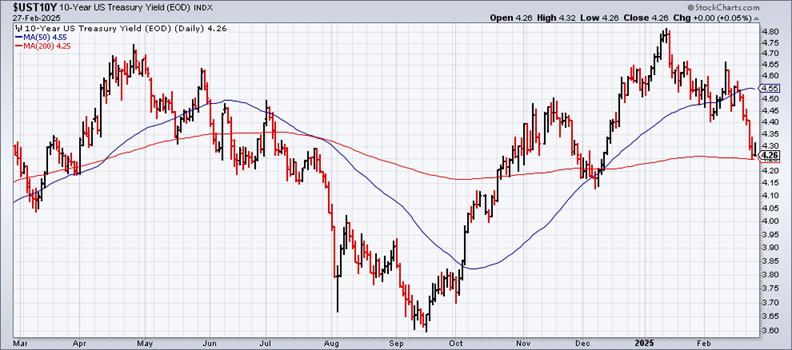Sticky inflation risk is still a threat for the bond market, but concern that the US economy is slowing has become the main factor driving Treasury yields lower recently.
The US 10-year yield steadied in yesterday’s trading (Feb. 27), but has dropped sharply in recent days, settling at 4.26% on Thursday – close to its lowest level since early December.
The drop in the 10-year rate is surprising given that progress on inflation has stalled recently. Although it’s premature to assume that inflation’s pace is accelerating, recent data suggests that disinflation has faded and so the Fed’s 2% inflation target remains elusive, at least for now. Consumer inflation’s year-over-year pace through January, for example, ticked up to a 3.0% year-over-year rate through last month for the headline measure, the highest since last June. The 1-year pace for headline CPI has now increased for four straight months. Core CPI also ticked higher, although this measure of inflation remains range-bound. Core CPI, a more robust measure of the trend vs. headline CPI, rose 3.3% in January vs. the year-ago level.
Despite the possibility that the Fed may be forced to start raising interest rates again to combat reviving inflationary pressures (or extend a pause on further rate cuts), investors are buying Treasury bonds and thereby driving down yields – exactly the opposite trend one would expect at a time when inflation concerns are bubbling anew. The reason: economic worries appear to be dominating market conditions.
Fueling the concern is yesterday’s new that US jobless claims rose more than expected last week, rising to highest level since December. The increase leaves claims far below a level that suggests elevated recession risk, yet some economists see the jump as a sign that the labor market is slowing.
“While still far below recession level, this is the highest number of weekly claims yet this year, and that’s a yellow caution light for the economy,” noted Andrew Stettner, unemployment insurance (UI) expert at The Century Foundation and former Biden administration UI modernization director. “What’s more, these worrying indicators don’t include hundreds of thousands of layoffs announced by the federal government.”
Anxiety about President Trump’s tariffs is a factor, analysts say:
“It’s a very difficult business environment, because they can’t plan for what their cost structure is going to be,” said Rachel Ziemba, an adjunct senior fellow at the Center for a New American Security. “It’s adding to investment uncertainty, and some people are holding back on investments.”
An economist at the conservative American Enterprise Institute also said that a firmer headwind is blowing for the US economy.
“There’s more uncertainty than I think is widely appreciated,” said Michael Strain. “All the uncertainty around trade policy, uncertainty around some of the things that the Department of Government Efficiency is doing, I think will have a chilling effect on investment plans and expansion plans.”
To be fair, a broad review of economic indicators still reflects moderate growth. But the rapidly changing policy arena piloted by the White House is changing the dynamic. As Torsten Sløk, Apollo chief economist, notes: the current challenge for evaluating the economy is balancing the upbeat numbers in the rearview mirror with the political risk that’s brewing in real time.
“We remain bullish on the economic outlook,” he wrote in a note this week, “but we are very carefully watching the incoming data for signs if this is an inflection point for the business cycle.”
